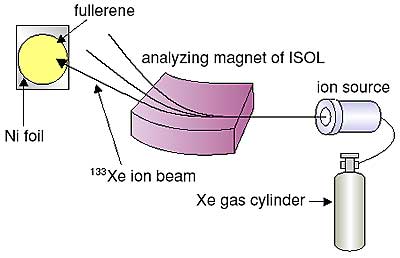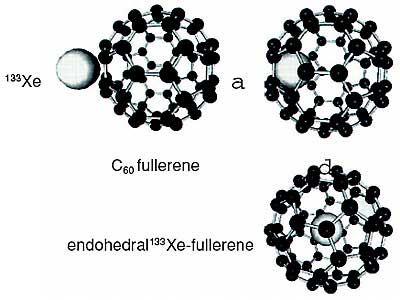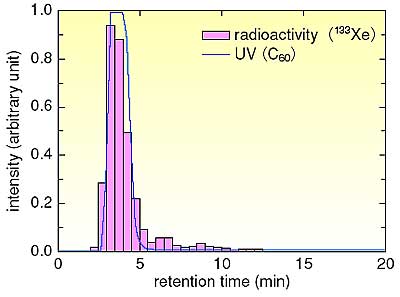Regarding fullerene species, one has C60 in the shape of a soccer ball, C70 (a rugby ball), and higher fullerenes such as C82, C84, etc. All of these fullerenes, which are hollow inside, can encapsulate one or more atoms in the interior space. These compounds are called endohedral fullerenes, and in particular the compounds encapsulating radioisotopes are called endohedral radioisotope-fullerenes.
The endohedral radioisotope-fullerenes offer the potential of becoming new radiopharmaceuticals. In order to realize this possibility, hydrophilic fullerene derivatives that are programmed to be transported only to desired tissues such as cancer cells have to be synthesized, in addition to the encapsulation of radioisotopes emitting beta- or gamma-rays suitable for therapy or diagnosis.
By using an Isotope Separator On-Line (ISOL), we have implanted 133Xe ions into fullerene targets made by vacuum evaporation of C60 or C70 onto Ni foils (Figs. 9-15 and 9-16). A high performance liquid chromatography (HPLC) analysis following dissolution of the fullerene targets in ortho-dichlorobenzene has corroborated the formation of endohedral 133Xe-fullerene, showing a strong correlation between C60 determined by ultraviolet spectrophotometry (UV) and 133Xe by gamma-ray spectrometry (Fig. 9-17). To our knowledge, the present work represents the first time that endohedral radioisotope-fullerene has been produced by ion implantation methods.
In order to produce new endohedral radioisotope-fullerenes, not only 133Xe but also other radioisotopes useful for therapy or diagnosis will have to be implanted into a fullerene host. From endohedral radioisotope-fullerenes so created, hydrophilic fullerene derivatives will be synthesized and applied to animal experiments in order to study their behavior in vivo. |



